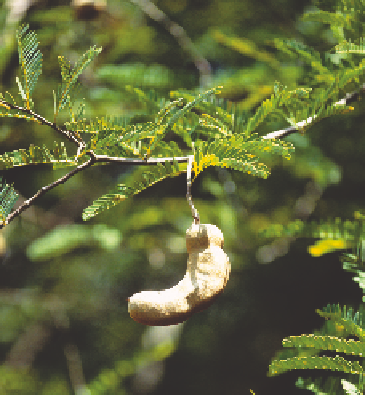Agriculture Reference
In-Depth Information
The dried plant part or liquid extract is administered to initiates of secret societies and members of
masquerade groups to enable them to see the gods and spirits of deceased relatives.
It is very important in the initiation ceremonies of the Bwiti tradition in Gabon, southern
Cameroon, equatorial Guinea Congo, and DR Congo. The root bark is eaten whole or crushed and
ground, rolled into small balls, and sometimes mixed with other ingredients; sometimes, a decoc-
tion of the crushed roots is taken. It is a true hallucinogen, assisting the initiate in self spiritual
discovery and to make contact with deceased relatives and ancestors and the spirit world, hence
enabling the individual to “come to terms with death.” After the initiation ceremony, the initiate is
reborn as an adult into the tribe, having been cleansed of illnesses and sociopsychological blockages
accumulated during childhood. Iboga is taken in these ceremonies in large quantities.
1140
The “magic of the Igbos” is also used in Ogbanje rituals to induce a state of psychosis in which
the user is believed to be capable of revealing objects he reputedly buried in former lives. The
Ogbanje phenomenon or
abiku
is prevalent in the southeastern Nigeria, where certain individuals,
mainly children, are believed to undergo repeated reincarnations at short intervals to the torment of
their parents at each death. Iboga preparations are believed to enable the Ogbanje during the resto-
ration rituals to reveal the place they hid their treasures in their previous lives to avert yet another
cycle of death and reincarnation or a social calamity on the entire community. Iboga is not a popular
drug of abuse and is usually restricted to religious and cultural ceremonies.
In the Congo, a root macerated in palm wine is used for coughs, urinary infections, and tooth-
ache and as an anthelmintic.
Constituents —
The dried roots contain about 6% indole alkaloids. The major narcotic alkaloid
in iboga is the indole alkaloid ibogaine, a tryptamine derivative, which is apparently restricted to
the genus. Other alkaloids found co-occurring with ibogaine include coronaridine, tabersonine, and
vocangine, as well as tabernanthine, ibogamine, kisanthine, and gabonine.
1022
Pharmacological Studies —
The principal alkaloid, ibogaine, is a strong CNS stimulant.
1023
It is a potent cholinesterase inhibitor. The compound possesses a hypotensive effect and stimulates
the appetite and digestion.
1024
After parenteral administration, ibogaine has been identified in vari-
ous biological materials, including blood and urine (humans) and in the liver, kidney, and brain of
laboratory animals. Ibogaine produces complex effects on locomotor activity in rodents.
1025
TAMARINDUS INDICA
Botanical Name —
Tamarindus indica
L.

